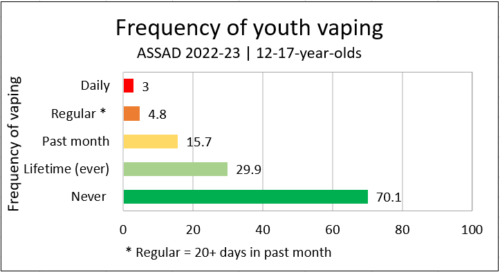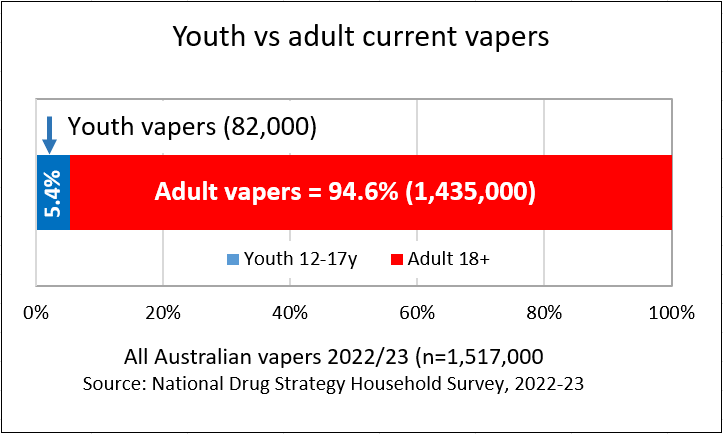
Youth vaping – the facts
Posted on May 28, 2024 By Colin
THE AUSTRALIAN MEDICAL ASSOCIATION and public health organisations are engaged in a media blitz on youth vaping to pressure MPs to pass the Vaping Reform Bill and entrench the prescription model. However, much of the case against youth vaping is based on "moral panic" and is emotive and misleading. Many of the risks are exaggerated.
Everyone agrees young people should not vape, smoke, drink alcohol, use illicit drugs or engage in other risky behaviours. The reality is that some young people will do these things, especially if we tell them not to. It is better they vape than smoke. Society’s role is not to ban the activities, but to reduce the harm they cause.
This blog reviews the scientific evidence on youth vaping in Australia. It outlines the risks, benefits and recommendations on how to minimise youth uptake.
Topics
- How common is vaping by Australian youth?
- Frequency matters
- How harmful is youth vaping?
- Does nicotine harm the adolescent brain?
- How common is nicotine dependence?
- How does the risk compare to other behaviours?
- Is youth vaping a fad?
- Is vaping a gateway to smoking?
- Vaping is displacing smoking
- What is the overall impact of vaping on youth?
- How should vaping be regulated to reducing youth vaping?
1. How common is vaping among Australian youth?
The 2022/23 ASSAD survey* found that while 29.9% had ever tried vaping (once or more)
- Only 3% vape daily
- 4.8% vape regularly (20+ days per month), and
- 15.7% vaped in the last month (once or more)
This is not an epidemic!

Vaping in Australia is largely an adult behaviour. Young people who vape make up 5-6% of the vaping population.

*ASSAD 2022-23 (Australian secondary school students’ use of tobacco and e-cigarettes) is Australia's largest survey of secondary school students, conducted every 3 years. The 2022-23 study involved 10,314 12-17-year-olds, surveyed at school.
2. Frequency matters
Never smokers
Only frequent vaping over the longer term by never-smokers has the potential to cause harm
However, this pattern of vaping is rare. Most youth vaping is experimental and temporary. Half of the young people who try vaping do so only once or twice (NDSHS 2023). Many never-smokers who vape long-term are likely to have otherwise smoked.
Smokers and former smokers
Regular vaping is largely confined to current or former smokers or those who would have otherwise smoked if vaping was not available. For these youth, vaping is likely to be beneficial.
3. How harmful is youth vaping?
Serious harmful effects to date are very rare. Most youth vape infrequently, especially those who have never smoked, so there is lower toxicant exposure in most cases.
Some young people have reported cough or wheeze from vaping. However, there is no clear evidence that vaping causes “functionally important” respiratory symptoms. Youth vaping is not linked with the onset of asthma (although smoking is).
New users who vape too much nicotine can get nausea, dizziness and feel faint. If this occurs, it is best to lie down and wait for it to pass. These symptoms settle quickly and are not serious.
Vaping nicotine does NOT cause seizures, pneumothorax (lung collapse) or serious lung disease such as "popcorn lung" or EVALI. There is a very rare risk of burns from lithium-battery explosions, a risk from all devices that use these batteries, such as mobile phones and laptops.
Nicotine itself is relatively benign. It does not cause cancer, heart or lung disease.
It is well established that smokers who quit by the age of 35 years have no permanent reduction in life expectancy. Vaping is at least 95% less harmful than smoking, so it is unlikely to cause serious harm, even after many decades of use.
However, there may be cardiovascular and lung effects in the long-term, but the absolute harm is likely to be very small.
[More]
4. Does nicotine harm the adolescent brain?
There is no evidence that nicotine causes harmful effects on the human adolescent brain.
Nicotine has been linked to harmful effects in animal studies which mostly use chronic, high-dose exposure. However, given species and dosing differences, the extrapolation of these findings to humans is speculative. The rodent brain is not a reliable proxy for the human brain.
Also, there is no long-term evidence of impaired brain function in the hundreds of millions of adults who smoked as adolescents and then stopped.
Studies of young people who smoked have not found any difference in IQ, educational achievement or cognitive abilities in adulthood between those who have smoked in the past and those who have never smoked.
[More]
5. How common is nicotine dependence?
Nicotine dependence from vaping is uncommon in young people who have never previously smoked. In Australian studies, about 3-5% of youth may have nicotine dependence. Some of these are former smokers who switched to vaping. This is not a "whole new generation addicted to nicotine" as the Health Minister keeps saying!
- In the ASSAD 2022-23 study, 5.5% of 12-17-year-olds believed they would experience at least some difficulty going without vaping
- In the NDSHS 2022-23: 3% of 14-17-year-olds reported being “unable to stop or cut down”.
Nicotine dependence can lead to withdrawal causing short-term symptoms such as irritability, restlessness, anxiety, difficulty concentrating and depression. These symptoms are unpleasant but not serious, and usually settle within 10-14 days of quitting. There are strategies to alleviate nicotine withdrawal, such as reducing the nicotine concentration or using nicotine gum or lozenges.
Nicotine dependence is mostly concentrated in young people who are current or past smokers.
[More]
6. How does the risk compare to other behaviours?
Vaping is one of the least risky risk behaviours of young people. Smoking, binge drinking, illicit drug use and drink-driving, bullying, mental illness, suicide attempts, sexual and other violence and car accidents cause far more harm.
In 2019, 63 Australian teenagers (14-19) died from alcohol. Among 14-17-year-olds in 2019 [AIHW]:
- 12.1% were victims of alcohol-related incidents in the past 12 months
- 8.9% engaged in risky drinking at least once a month
- 9.7% used illicit drugs
- 5.9% experienced an incident of illicit drug-related harm
No teen or adult has ever died from vaping nicotine.
7. Is youth vaping a fad?
Youth vaping has declined or plateaued in many countries. In the US, vaping by high schoolers peaked at 27.5% in 2019. Over the next 4 years, it dropped to 10%, a decline of 64%. Declines are also being seen in Canada and New Zealand and will likely occur in Australia too, just like the use of Pokemon and fidget spinners.

8. Is vaping a gateway to smoking?
There is no good evidence that vaping is a gateway to youth smoking. Young people who try vaping are more likely to try smoking, drink alcohol, use illicit drugs and have unprotected sex. That does not mean vaping causes those other behaviours.
If vaping was a gateway to smoking, we would expect to see smoking rates increase. In fact, numerous studies in many countries have shown that smoking rates are declining faster as vaping rates increase. A more plausible explanation for the association between smoking and vaping is that young people who try vaping are simply also predisposed to try smoking due to common characteristics such as mental illness, genetic factors, peer pressure and social circumstances. This is known as having a “common liability” for nicotine use or risk-taking.
Furthermore, those who vape first (before smoking) are less likely to smoke later, compared to those who smoke first.
[More]
9. Vaping is displacing smoking
Many studies have found that vaping and smoking are substitutes and that vaping is diverting young people AWAY FROM smoking. When access to vaping is restricted by bans, increased price or age restrictions, smoking rates increase, indicating that vaping and smoking are substitutes.
Some young smokers are also using vaping to quit smoking.
In Australia in 2023, only 2.1% of 12-17-year-olds smoked in the past week and 0.3% smoked daily. (ASSAD)
[More]
10. What is the overall impact of vaping on youth?
A risk assessment of the benefits and harms of vaping suggest that vaping is beneficial overall to young people. The harms of vaping are mostly small. However, there are substantial benefits from diverting young people away from deadly smoking and from helping current smokers to quit.
Nicotine also has beneficial effects. It reduces anxiety and relieves depression. It improves attention, working memory and cognitive function. Nicotine is beneficial for certain medical conditions such as ADHD and schizophrenia. There are also social benefits from vaping, as there are from smoking.
This is not to endorse youth vaping. Kids should not smoke or vape. However, many will vape anyway and the net impact of youth vaping is likely to be positive.
Young people benefit from vaping in society. Vaping helps their parents quit smoking and avoid early death. It also reduces pressure on the family budget and eliminates the risk of copying their smoking behaviour (role modelling). Parental vaping instead of smoking reduces secondhand exposure at home.
Mendelsohn CP. It’s time to change the way we look at youth vaping. Filter, 14 July 2023
11. How to regulate youth vaping?
High levels of youth vaping are largely a result of failed regulations
Under current Australian law, adult vapers are required to have a doctor’s prescription for nicotine to vape legally, but very few are willing to get one. This has created a thriving black market run by organised crime groups, which supply dodgy, unregulated vapes freely to teens through rogue convenience stores and tobacconists or via social media.
Eliminating the black market is the key to reducing youth vaping. The only way to eliminate the black market is to replace it with a legal, regulated one.
A tightly regulated, risk-proportionate consumer model with strict age verification would make regulated vaping products more available for adults who smoke, reduce illicit sales and make vapes less accessible and less appealing to young people.
Measures to reduce youth access and appeal include:
- Vaping products sold from licensed retail outlets where strict age verification is available such as vape shops and retail outlets where tobacco is sold. Sales to youth should result in severe fines and loss of licence.
- Flavour names that specifically appeal to young people such as ‘dragon vomit’ should be banned and only simple flavour descriptors such as caramel or blueberry used.
- Packaging should be simple, without bright colours and images with youth appeal.
- Honest and accurate education to young people on the risks of vaping.
- Advertising should be restricted and regulated to prevent marketing appealing to adolescents
- Online retailers should verify the age of the purchaser with a third-party age verification service.
- Verification of age on delivery.
- Public and youth education to frame vaping as a smoking cessation tool or a safer alternative for adult smokers. There should be a clear message that vaping is not for young people or non-smokers.
- Mandatory CCTV at point-of-sale to ensure compliance
Go to Top